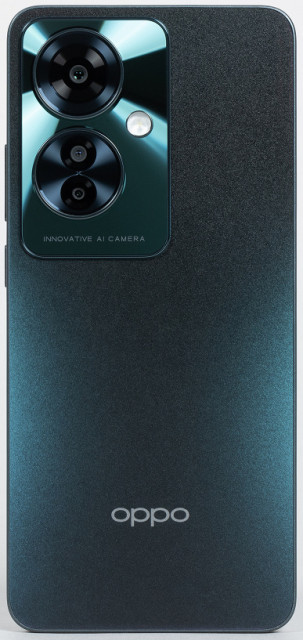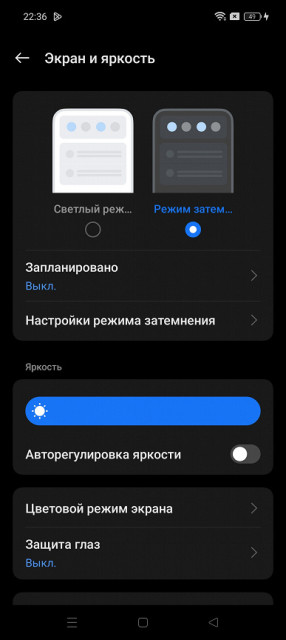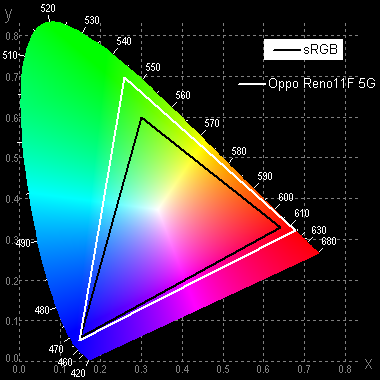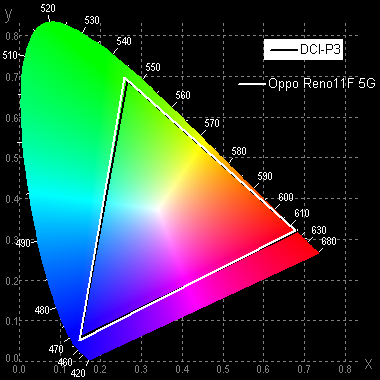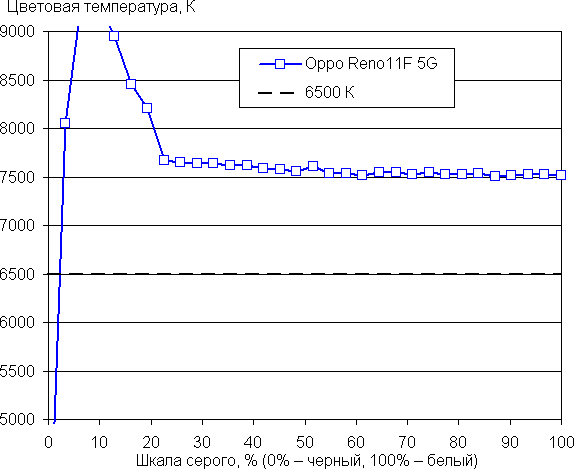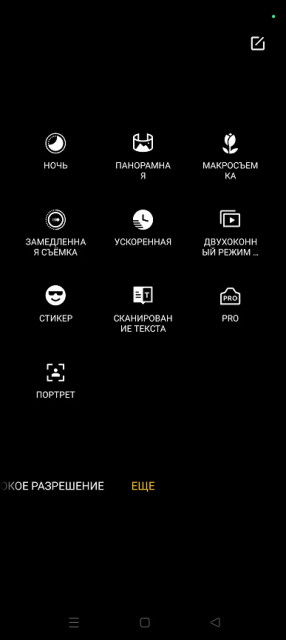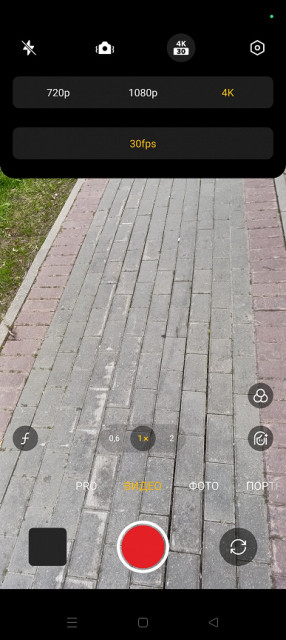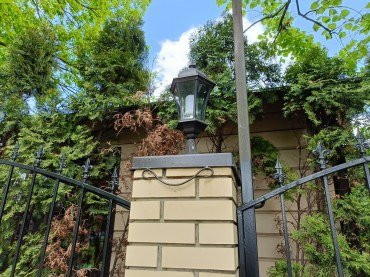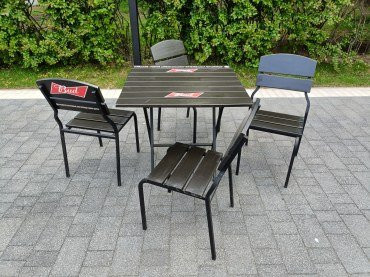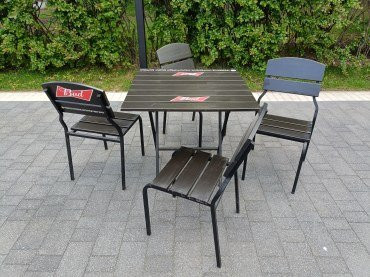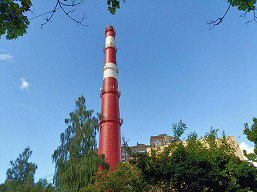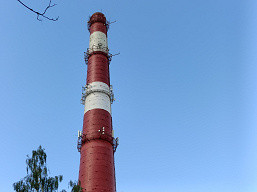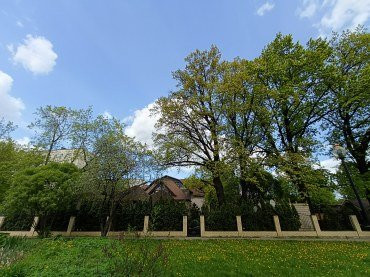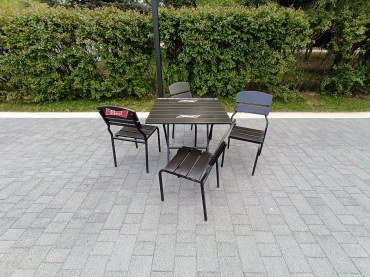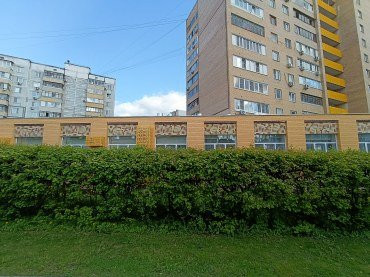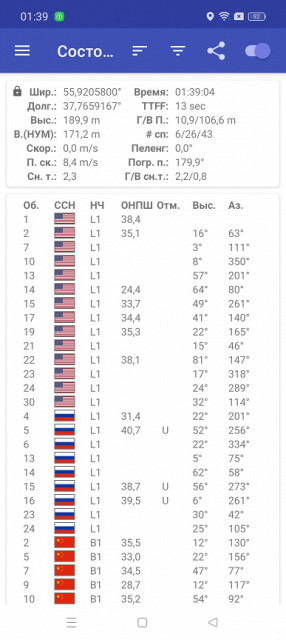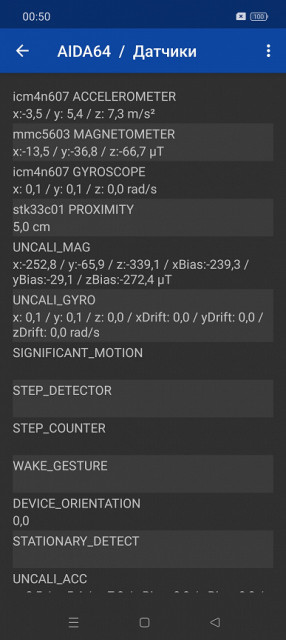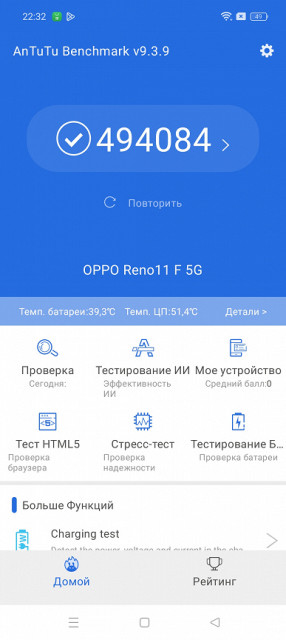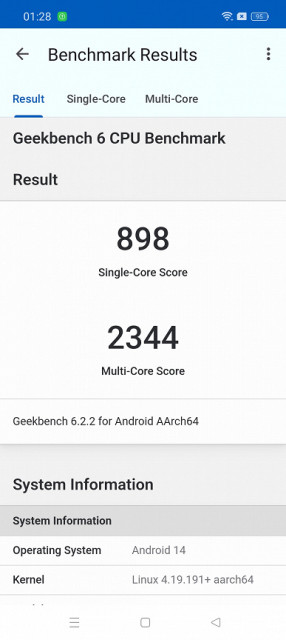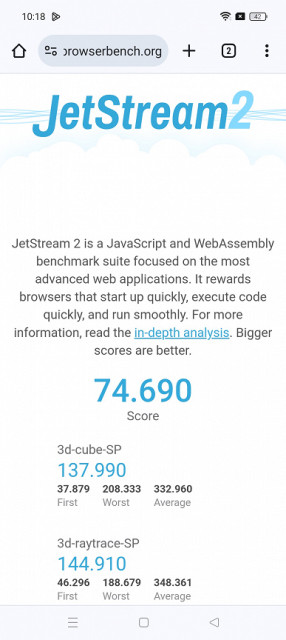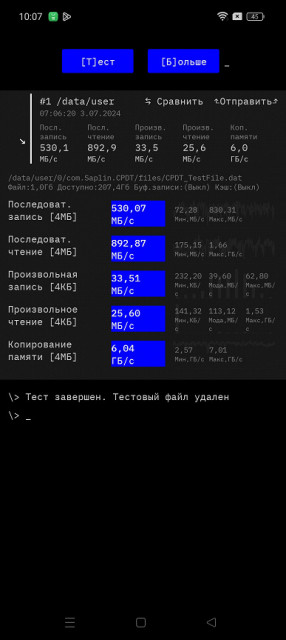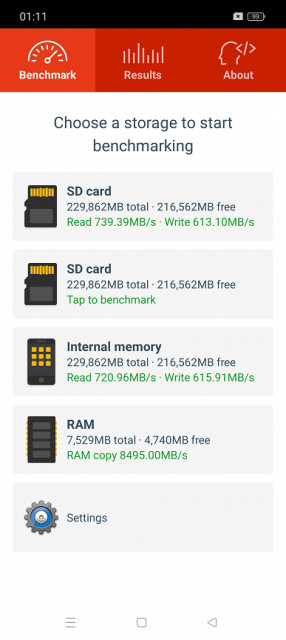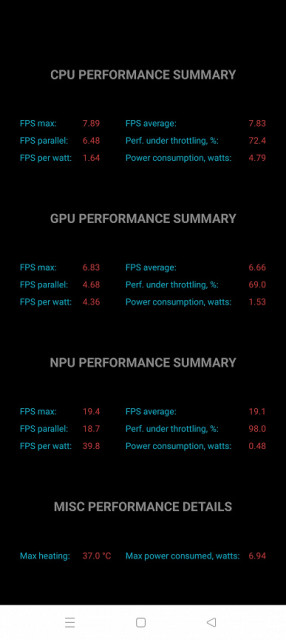The Oppo brand has announced a new generation of Reno series smartphones. In our region, the Reno11 line is represented by two models: the flagship Oppo Reno11 5G and the more affordable, but less technically equipped Oppo Reno11F 5G, which we will talk about today.
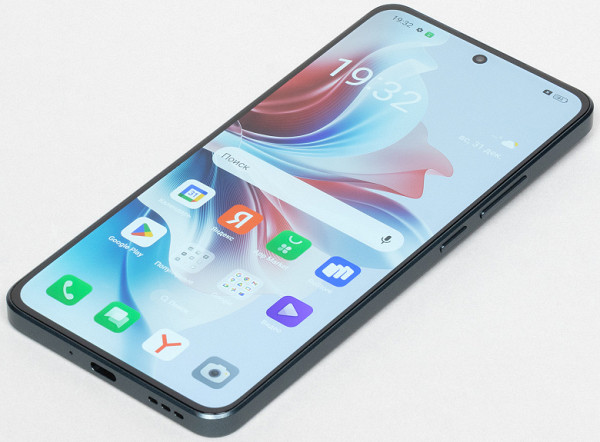
Key Features of Oppo Reno11F 5G (Model CPH2603)
- SoC Mediatek Dimensity 7050, 8 processor cores (2×Cortex-A78 @2.6 GHz + 6×Cortex-A55 @2.0 GHz)
- GPU Mali-G68 MC4
- OS Android 14, ColorOS 14
- Touchscreen AMOLED, 6.7″, 1080×2412, 20:9, 394 ppi, 120 Hz
- RAM 8 GB, internal memory 256 GB
- Support microSD (combined slot)
- Support Nano-SIM (2 pcs.)
- Networks 2G GSM, 3G WCDMA, 4G LTE, 5G
- GPS, GLONASS, BDS, Galileo
- Wi-Fi 6 (2.4 and 5 GHz)
- Bluetooth 5.2, A2DP, LE, aptX HD, LHDC
- NFC
- USB 2.0 Type-C, USB OTG
- no 3.5 mm audio output for headphones
- Cameras 64 MP + 8 MP (wide) + 2 MP (macro), video 4K@30 fps
- Front camera 32 MP
- Proximity and light sensors, magnetic field, accelerometer, gyroscope
- Fingerprint scanner (under the screen)
- Battery 5000 mAh, charging 67 W (PD2.0, QC3)
- Dimensions 161×75×7.5 mm
- Weight 177 g
Appearance and ease of use
The Oppo Reno11F 5G smartphone comes in a cardboard box with a discreet, simple design.

The kit includes a 67W power supply, a connecting cable and a protective case.

The design of the Oppo Reno11F 5G is so minimalistic that there is no need to describe it. It corresponds to modern trends: strict, relevant shapes without unnecessary bends. The front and back panels are flat, and the side edges are wide and not narrowed, which ensures a comfortable and secure grip.
The side frame is made of matte plastic with a metallic effect, and the back panel has the same matte finish, without gloss or shine. As a result, the smartphone is practical, not prone to the appearance of marks, but the appearance remains quite modest.

The cameras on the back are combined into a protruding block, which has a mirrored, easily soiled surface.
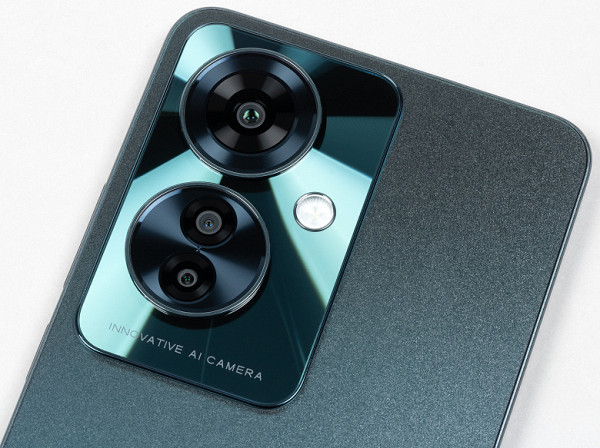
The smartphone is large but light. It weighs only 177 grams, which is rare these days. The included case is translucent and flexible.
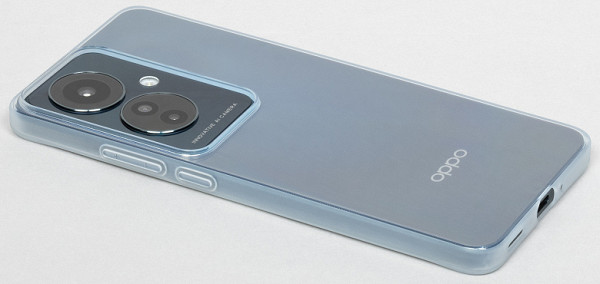
The side buttons are wide enough, with a long, springy stroke. They are conveniently located on one side, right under the fingers.

A single front camera lens is installed behind a round cutout in the screen matrix in the center of the top edge.
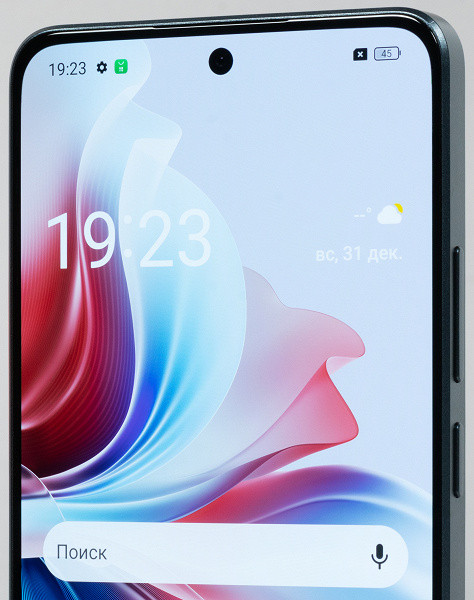
The fingerprint scanner is located under the bottom of the screen glass. The scanner is optical, works clearly, but not very quickly.
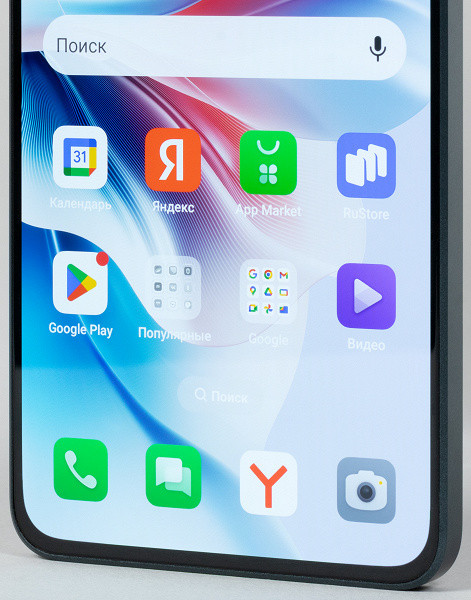
The sliding tray can accommodate two Nano-SIM cards or replace one of them with a microSD memory card.
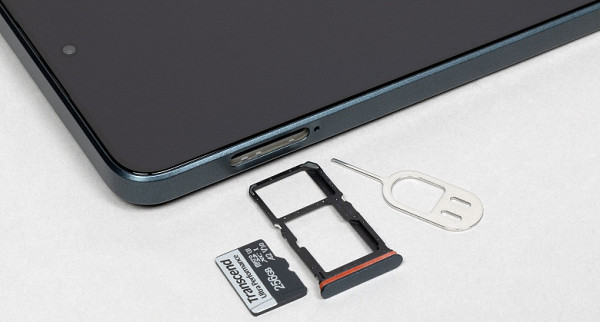
The bottom end houses a speaker, microphone and USB Type-C connector.

The top edge is given over to an additional microphone. There is no 3.5 mm audio output, no IR port, no second speaker for stereo sound.

Oppo Reno11F 5G is available in two colors — green and blue. The body is protected from moisture and dust according to the IP65 standard.
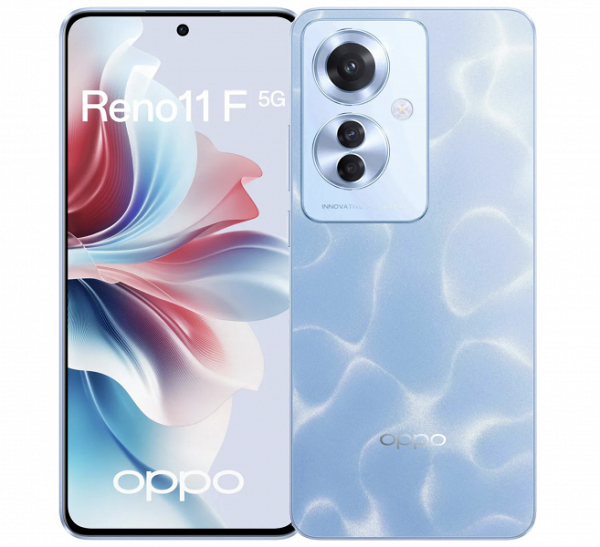
Screen
The Oppo Reno11F 5G smartphone features a 6.7-inch AMOLED display with a resolution of 1080×2412 (aspect ratio 20:9), protected by flat Panda Glass. The screen dimensions are 70×156 mm, and the pixel density reaches 394 ppi. The side frames around the display are 2 mm wide, and the top and bottom are 3 mm. The screen supports a refresh rate of 120 Hz.
The front surface of the screen is made of mirror-smooth glass that is resistant to scratches. The reflective properties of the screen are slightly better than those of the Google Nexus 7 (2013) (hereinafter simply Nexus 7). The outer surface of the screen has an effective oleophobic coating, which significantly simplifies the removal of fingerprints and slows down their appearance compared to ordinary glass.
When manually adjusting the brightness and displaying the white field on the entire screen, the maximum brightness reaches 470 cd / m², and in bright light it increases to 870 cd / m², which is a very high figure. At the same time, the smaller the area of white on the screen, the brighter it is, so the actual maximum brightness of white areas almost always exceeds the specified values. Thanks to excellent anti-glare properties, the screen should be easy to read even in bright sunlight. The minimum brightness is 2 cd / m², which allows you to reduce it to a comfortable level in complete darkness. Automatic brightness adjustment works based on the light sensor located under the screen to the right of the front camera. In automatic mode, the screen brightness is adjusted depending on the level of external light. The user can adjust this level using the brightness slider. In complete darkness, auto-brightness reduces the level to 7 cd/m² (which is a bit dark), in a lit office (approximately 550 lux) it sets about 100 cd/m² (acceptable), and in bright sunlight it increases to 870 cd/m² (maximum). We found this result not entirely satisfactory, so we slightly increased the brightness in complete darkness, obtaining 16, 110 and 870 cd/m² for the three mentioned conditions. Thus, the auto-brightness function works adequately and allows the user to adjust it to their preferences.
At high and medium brightness levels, there is significant modulation with a frequency of approximately 60, 90 or 120 Hz. The image below shows graphs of brightness (vertical) versus time (horizontal) for several brightness settings, first in 60Hz mode:
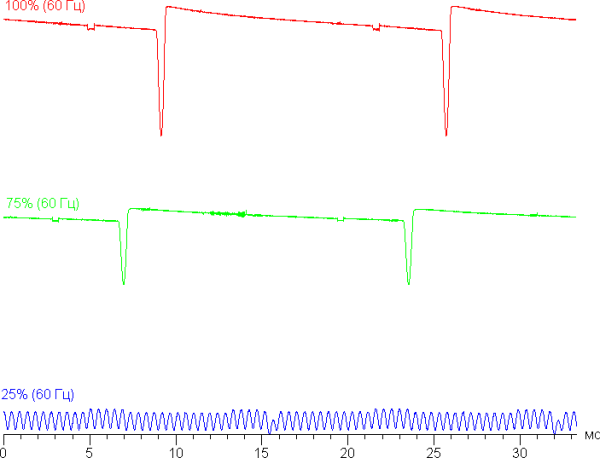
At high and medium brightness, the modulation has a low duty cycle, so there is no visible flickering, despite the frequency of only 60 Hz. With a significant decrease in brightness, modulation with a high fundamental frequency (2160 Hz) appears, which also prevents visible flickering.
In the screen settings, you can activate a mode with an increased refresh rate of up to 120 Hz:

In 120Hz mode, the smoothness of scrolling menu lists increases noticeably. Let's see if the modulation character changes:

At high and medium brightness, the modulation frequency doubles, but at low brightness the modulation pattern remains the same, so there is no flickering. In the settings, you can set the maximum refresh rate for each application, limiting it to 60, 90 or 120 Hz.

Modulation at 90 Hz:
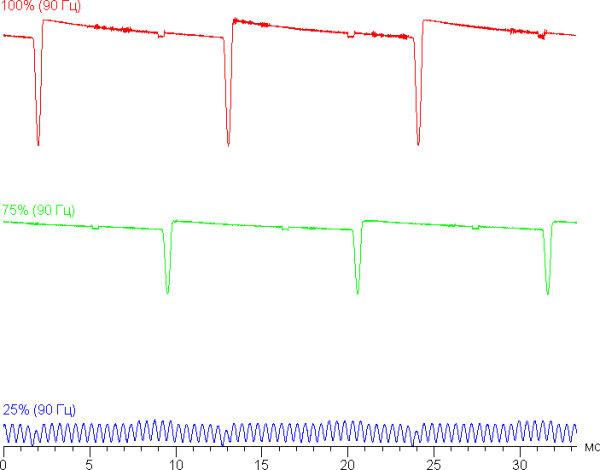
As expected, at high and medium brightness the modulation frequency is 90 Hz, and at low brightness it is 2160 Hz, so there is no flickering.
This screen uses a Super AMOLED matrix with an active matrix on organic light-emitting diodes. The full-color image is formed by subpixels of three colors — red ®, green (G) and blue (B), but there are half as many red and blue subpixels, which can be designated as RGBG. This is confirmed by a fragment of a microphotograph:

In the given fragment, you can see 4 green subpixels, 2 red (4 halves) and 2 blue (1 whole and 4 quarters). These fragments are repeated, forming the entire screen without gaps and overlaps. Samsung calls this type of matrix PenTile RGBG. The screen resolution is calculated by green subpixels, and it will be lower for red and blue ones. Because of this, small irregularities in contrasting borders and other artifacts may occur, but due to the high resolution, their impact on image quality is minimal.
The screen has excellent viewing angles. Although the brightness decreases noticeably at an angle, especially with LCD screens, this smartphone has a less pronounced drop in brightness, so the screen visually seems brighter even at a slight tilt. However, at significant angles of deviation, white can acquire a barely noticeable blue-green tint. Black remains richly black at any angle, which makes the contrast ratio irrelevant for evaluation. For comparison, here are some photos where the same images are displayed on the screens of a smartphone and another device. The brightness of both screens is set to 200 cd/m², and the color balance of the camera is set to 6500 K.
View of the screen at a right angle:

Note the good uniformity of brightness and color tone of the white field.
And the test image:

The colors on the smartphone screen look oversaturated (pay attention to the tomatoes, bananas, napkin and face color), and the color balance is noticeably different. We remind you that the photo is not a reliable source of information about the quality of color rendering and serves only as a conditional illustration. In particular, the pronounced reddish tint of white and gray in the photos of the smartphone screen is not observed when viewed at a straight angle, which is confirmed by tests using a spectrophotometer. This is due to the fact that the spectral sensitivity of the camera matrix does not fully coincide with the perception of human vision.
The photo was taken for the "Bright colors" profile, which is installed by default. There are two profiles available:

When choosing the Natural profile profile, the situation is better:
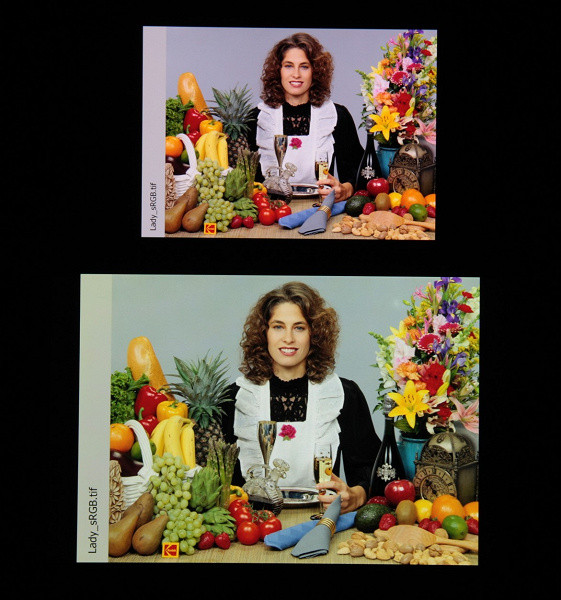
Color saturation is normal, and there is no increase in color contrast.
Switching of the matrix elements state occurs almost instantly. However, at the switching front, a step of approximately 17 ms wide (which corresponds to a screen refresh rate of about 60 Hz), about 11 ms (90 Hz) or about 8 ms (120 Hz) can be observed. For example, the dependence of brightness on time when switching from black to white looks like this:
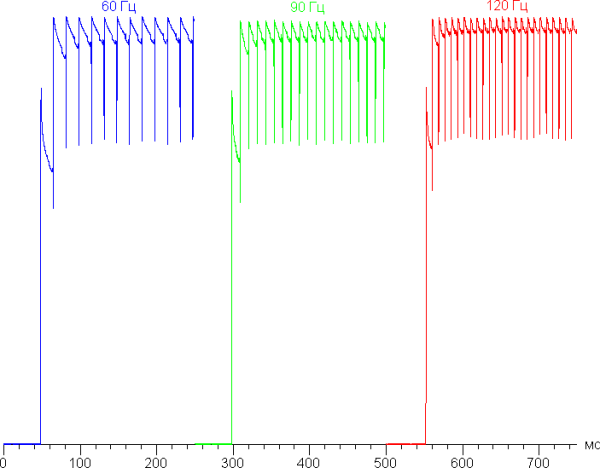
Bazı koşullar altında böyle bir adım, hareket eden nesnelerin arkasından takip eden bulutların ortaya çıkmasına neden olabilir.
Gri tonlarında eşit aralıklarla 32 nokta kullanılarak oluşturulan gama eğrisinin analizi, parlak noktalarda ve gölgelerde önemli bir yuvarlanma olmadığını gösterdi. Güç işlevi uyum üssü 2,27'dir; bu, standart değer olan 2,2'den biraz daha yüksektir, bu da görüntünün biraz koyulaşmasına neden olabilir. Bu durumda, gerçek gama eğrisi güç yasası bağımlılığından neredeyse hiç sapmaz:
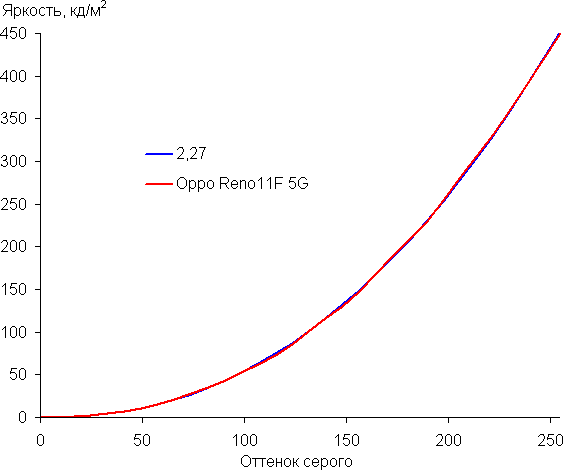
Let us remind you that for OLED screens, the brightness of image fragments changes dynamically depending on the displayed content — for generally bright images, the brightness may decrease slightly. Therefore, the dependence of brightness on hue (gamma curve) may not exactly correspond to the gamma curve of a static image, since the measurements were taken with sequential output of gray shades on the entire screen.
The color gamut in the «Vivid colors» mode exceeds sRGB and is close to DCI-P3:
When you select the Natural gamut profile, it is compressed almost to the sRGB limits:

In the case of the Bright Colors profiles, the component spectra are very well separated, which allows for wide coverage:

In the case of the Natural profile with maximum coverage correction, the color components are mixed with each other to a significant extent:
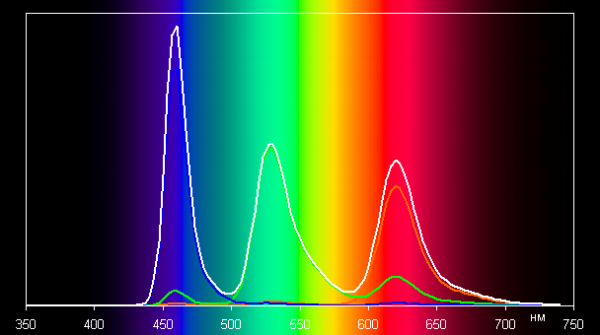
In the case of the Natural profile with maximum coverage correction, the color components are mixed with each other to a significant extent:
(The darkest areas of the gray scale can be ignored, since the color balance in them is less important, and the measurement error at low brightness is large.)
This device has the ability to adjust the color balance using the slider to adjust the cool-warm hue. However, when you change this slider, the color gamut is reset to the level corresponding to the «Vivid colors» profile. Therefore, for more accurate color rendering, it is recommended to select the «Natural» profile, where natural saturation is more important than the accuracy of the color balance.
In addition, in the settings, you can reduce the intensity of blue.

Bright light can disrupt your circadian rhythm, but this can be easily fixed by reducing the brightness to a comfortable level. Reducing the blue component is impractical and can upset the color balance, and also resets the color gamut correction.
This device does not seem to support DisplayPort Alt Mode for USB Type-C, which means there is no way to output image and sound to external devices via the USB port.
Let's sum it up. The screen has a very high maximum brightness (up to 870 cd / m²) and excellent anti-glare properties, which allows you to comfortably use it outdoors even on a sunny day. In complete darkness, the brightness can be reduced to 2 cd / m². The automatic brightness adjustment mode works adequately. The advantages of the screen include an effective oleophobic coating, no visible flickering, a high refresh rate mode (up to 120 Hz) and a color gamut close to sRGB with the right profile. It is also worth noting the general advantages of OLED screens: true black color (if the screen does not reflect light), good uniformity of the white field and less loss of brightness when viewed at an angle compared to LCD screens. In general, the quality of the screen is very high.
Camera
The Oppo Reno11F 5G smartphone is equipped with three rear cameras:
- 64 MP, 1/2.0″, 0.7 µm, f/1.7, 25 mm, PDAF (main)
- 8 MP, 1/4.0″, 1.12 µm, f/2.2, 16 mm, 112˚ (wide-angle)
- 2 MP, f/2.4 (macro)
The main camera uses an OmniVision OV64B sensor and is equipped with electronic stabilization and phase autofocus. By default, the camera takes photos at 16 MP using 4-in-1 pixel binning, but you can also switch to full 64 MP resolution. In 64 MP mode, photos have significantly better detail, the image looks high-quality even at full zoom, with little noise. If you have enough space on your system drive, you can safely use this mode (the size of photos is about 8 MB in 16 MP and 28 MB in 64 MP).
The smartphone demonstrates quite good results in shooting. Although you can notice some blurring in the corners, not always maximum detail and sometimes excessive increase in contour sharpness, 16-megapixel photos are generally high-quality and pleasing to the eye. They are sharp, contrasty, voluminous and saturated, with good elaboration of light and dark areas, without noticeable highlights and underexposed areas.
Here are more examples of photos taken with the main camera in auto mode:
The results for night photography are quite acceptable, although the detail in the dark is significantly reduced. The image processing is not excessive, and such photos are quite suitable for miniatures, especially with adequate exposure.

The smartphone does not have a telephoto lens, so the zoom is digital only. However, for 2x zoom, a crop is used from a full-size 64-megapixel photo, which preserves more details. As a result, the picture remains detailed and high-quality, and this mode is recommended for use. The maximum level of digital zoom is 10×.
The wide-angle module with the Sony IMX355 sensor provides a less detailed image: there is some looseness, blurring at the edges and distortion of the geometry of objects. However, the photos remain quite saturated with adequate color rendition.
The smartphone shoots video in 4K resolution at 30 frames per second, but to achieve 60 fps you will have to reduce the resolution. In 4K, the picture is rich and contrasty, but the lack of stabilization leads to jerking and strobing of the video sequence.
Electronic stabilization is available only at 1080p resolution, where the picture is significantly smoothed, but the quality still leaves much to be desired: there are jello and jerking effects, and detail is noticeably reduced and blurriness appears. Video shooting on this smartphone is not impressive, and it is better to use a tripod for static shooting in 4K. Sound is recorded well.
The selfie camera with a resolution of 32 MP (f / 2.4) provides good pictures without overexposure and color distortion. It demonstrates good contrast, volume and decent detail, which makes it suitable for creating high-quality portraits.

Telephone and communications
The Oppo Reno11F 5G smartphone has standard network functions: support for most 4G and 5G mobile network ranges, two Wi-Fi 6 ranges, Bluetooth 5.2 and NFC. e-SIM is not supported. In the conditions of the Moscow urban region, the device shows reliable operation in wireless networks, without losing connection and quickly restoring it after interruptions. All the necessary sensors, including a gyroscope, are present.
Single-channel satellite navigation, supports GPS, GLONASS, BDS and Galileo. With a cold start, satellites are detected quickly, positioning accuracy is high.
The speaker is loud enough, the voice of the interlocutor is clearly audible. The vibration call has an average power.
Software and multimedia
The Oppo Reno11F 5G smartphone runs on Android 14 with the ColorOS 14 shell. The shell is neat and well optimized, has an adequate Russian translation and a laconic design. However, there is an intrusive layer, which, despite its appearance of checking installation files, actually contains a lot of advertising, which is reminiscent of the Xiaomi experience. There are also many pre-installed unnecessary applications.
The notification shade is not divided into two parts. The Google Play app store and access to Google services are present.
The smartphone produces good, loud and clear mono sound. There is no 3.5 mm audio output for wired headphones.
Performance
The Oppo Reno11F 5G smartphone is equipped with an eight-core Mediatek Dimensity 7050 SoC and a Mali-G68 MC4 GPU. It has 8 GB of LPDDR4x RAM and 256 GB of built-in UFS 3.1 storage, with the ability to expand the memory card if you refuse the second SIM card. External devices can be connected via the USB Type-C port in USB OTG mode.
The chipset, announced on May 2, 2023 and manufactured using a 6-nanometer process technology, is not the most powerful — in AnTuTu, it scores about 500 thousand points, which corresponds to the average level. The performance is sufficient for everyday tasks and smooth operation of the interface, but it cannot record 4K video at 60 fps. You can play games, but not at maximum settings.
Testing in complex tests AnTuTu and GeekBench:
The smartphone's test results in the latest versions of popular benchmarks are presented in tables. For clarity, the tables also include data from several other devices from different segments, tested on the same versions of benchmarks. Since it is impossible to present results from different versions of benchmarks in one comparison, some relevant and worthy models remain behind the scenes, as they were tested on previous versions of test programs.
| Oppo Reno11F 5G (MediaTek Dimensity 7050) | Infinix GT 20 Pro (Mediatek Dimensity 8200 Ultimate) | Redmi Note 13 Pro+ (Mediatek Dimensity 7200 Ultra) | Vivo V30e (Mediatek Dimensity 8200 Ultimate) | Realme 12 Pro+ (Qualcomm Snapdragon 7s Gen2) | |
|---|---|---|---|---|---|
| AnTuTu (v9.x) (bigger is better) | 494084 | 864843 | 662986 | 489575 | 576685 |
| GeekBench 6 (bigger is better) | 898/2344 | 1258/3465 | 1248/2914 | 939/2871 | 894/2801 |
Testing the graphics subsystem in GFXBenchmark gaming tests:
| Oppo Reno11F 5G (MediaTek Dimensity 7050) | Infinix GT 20 Pro (Mediatek Dimensity 8200 Ultimate) | Redmi Note 13 Pro+ (Mediatek Dimensity 7200 Ultra) | Vivo V30e (Mediatek Dimensity 8200 Ultimate) | Realme 12 Pro+ (Qualcomm Snapdragon 7s Gen2) | |
|---|---|---|---|---|---|
| GFXBenchmark Aztec Ruins OpenGL (Onscreen, fps) | 29 | 75 | 51 | 29 | 35 |
| GFXBenchmark Aztec Ruins Vulkan (Onscreen, fps) | 24 | 77 | 55 | 31 | 39 |
| GFXBenchmark Car Chase ES 3.1 (1080p Offscreen, fps) | 26 | 65 | 43 | 24 | 30 |
| GFXBenchmark Manhattan ES 3.1 (1080p Offscreen, fps) | 42 | 121 | 74 | 45 | 54 |
| GFXBenchmark T-Rex (1080p Offscreen, fps) | 103 | 292 | 190 | 106 | 122 |
Testing in browser cross-platform tests:
| Oppo Reno11F 5G (MediaTek Dimensity 7050) | Infinix GT 20 Pro (Mediatek Dimensity 8200 Ultimate) | Redmi Note 13 Pro+ (Mediatek Dimensity 7200 Ultra) | Vivo V30e (Mediatek Dimensity 8200 Ultimate) | Realme 12 Pro+ (Qualcomm Snapdragon 7s Gen2) | |
|---|---|---|---|---|---|
| Google Octane 2 (bigger is better) | 32023 | 45083 | 35962 | 33442 | 30529 |
| JetStream (bigger is better) | 75 | 106 | 125 | 93 | 85 |
Memory speed test results:
Heat
We test for performance degradation when heating using the Burnout Benchmark program, which allows you to load the CPU, GPU and NPU:
| Load on | Heating performance, as a percentage of maximum |
|---|---|
| CPU | 29% |
| GPU | 48% |
| NPU | 98% |
Battery life
The Oppo Reno11F 5G smartphone is equipped with a 5000 mAh battery and demonstrates good autonomy in tests.
Testing was carried out at a standard power consumption level, without enabling the power-saving features that are present in the device. Test conditions: minimum comfortable brightness (about 100 cd / m²). Tests included endless reading in Moon + Reader (with a normal light theme), continuous playback of HD video (720p), and the game Injustice 2 with automatic graphics settings.
| Battery capacity | Reading mode | Video mode | 3D gaming mode | |
|---|---|---|---|---|
| Oppo Reno11F 5G | 5000 mAh | 22:00 | 19:00 | 7:00 a.m. |
| Infinix GT 20 Pro | 5000 mAh | 19:00 | 16:00 | 6 h 30 min |
| Tecno Pova 6 Pro 5G | 6000 mAh | 22:00 | 20:00 | 7:00 a.m. |
| Infinix Note 40 Pro | 5000 mAh | 18:00 | 15:00 | 6:00 a.m. |
| Tecno Spark 20 Pro+ | 5000 mAh | 18:00 | 14:00 | 6:00 a.m. |
| Vivo V30 | 5000 mAh | 23:00 | 21:00 | 8:00 a.m. |
These results represent the maximum figures achieved under «ideal» conditions, including no SIM cards installed. In real-world conditions, the results may be less impressive.
The smartphone fully charges from the included power adapter in 1 hour 10 minutes. Wireless charging is not supported.
Results
The Oppo Reno11F 5G smartphone can be described as a solid «mid-range»: it does not stand out with outstanding characteristics, but also has no obvious drawbacks. Its strong point is a high-quality AMOLED screen, while battery life and performance are average, and the design is moderately calm. The camera takes good pictures, but video shooting leaves much to be desired. In general, this is a reliable mid-range smartphone without any special frills.
In the official retail in Russia, Oppo Reno11F 5G is sold for $ 437 for the version with 8/256 GB of memory, which seems like an inflated price. However, discounts are available in the summer, and now the model can be purchased for $ 327. It is a pity that local marketers add unnecessary advertising and affiliate programs to the devices, which somewhat spoils the overall impression.


